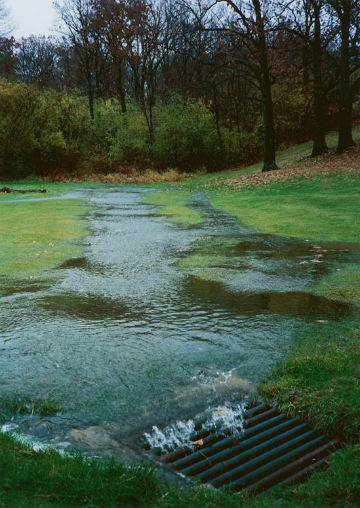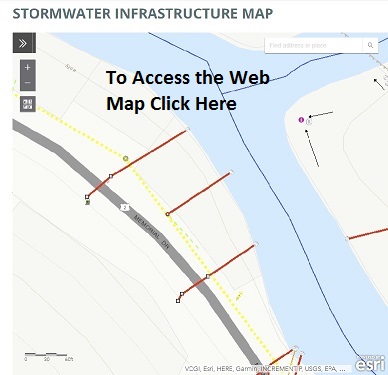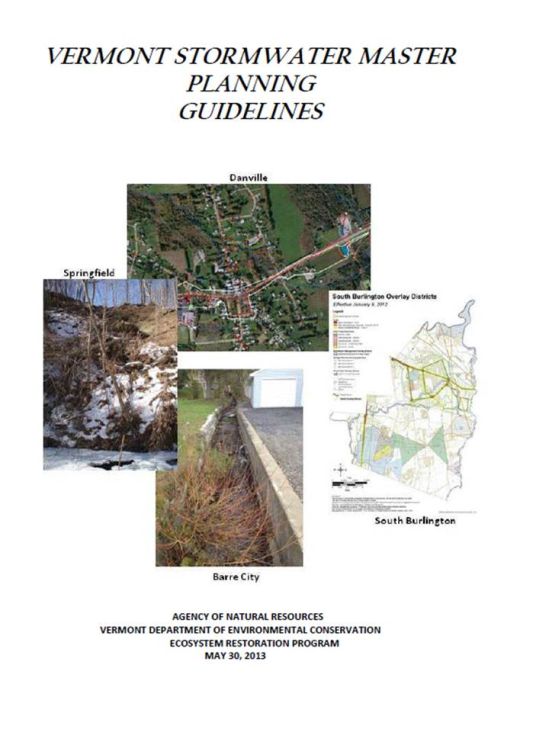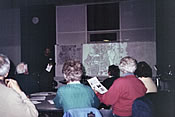Stormwater Primer

When Rain Becomes a Problem
By Joan Martin
“What a beautiful day!" I'll bet the image that brings to mind is not a cloudy drizzle or a thunderstorm. We love a beautiful sunny day and usually react to rain as a nuisance that hopefully will soon be gone. Consequently, we don't design rain into our lives.
We especially don't design rain into our built spaces. We design our buildings and landscapes in a fantasy, as if rain didn't exist. Then, when the rain falls, we have a problem that we call "stormwater," which we try to move off the site as efficiently as possible, usually through a system of drains. The typical solution is to run it to the creek.
However, this approach has serious repercussions for the environment around our community. We can have much better designs if we ask for them, and it would be a great gift to our grandchildren if we did. Our guide to a desirable design lies in the natural environment.
We don't talk about stormwater in the woods because very little of the rain leaves the site. On the other hand, when it rains in town, the water cannot soak into the ground so most of the stormwater flows rapidly off the site, washing the impervious pavement and the roofs. You can see the results of washing the streets and other surfaces when you notice the trash that ends up in the river. The chemicals we use on our lawns and the oil and dirt in the streets are also washed into the stream, polluting it. Equally damaging are the physical effects of the stormwater on the creek. When a great surge of stormwater flows rapidly to the creek, it changes a steady gentle stream into a powerful torrent that gouges the channel, tearing away the banks and clogging with dirt the gills of fish and the homes of streambed creatures.
It is very understandable that our response to the excess water has been to remove it from the city and hasten its trip to the nearest stream. It wasn't part of what we planned in our life. However, a far better way to handle the excess water is to recreate what we have lost in order to keep the water from leaving the site on which it falls.
What would our civilized world be like if we did include rain in the design? We could provide a place for water, both by utilizing the natural systems that hold and cleanse rainwater, such as wetlands and floodplains, and by constructing reservoirs and beautiful "wet gardens" - gardens filled with water-loving plants that absorb excess nutrients and other contaminants from the water.
Republished with permission from U.S. EPA
Legislative History
In 2000 the Vermont Legislature required the Department of Environmental Conservation (VTDEC) to implement a statewide program to: “Encourage municipal governments to utilize existing regulatory and planning authority to implement improved stormwater management by providing technical assistance, training, research and coordination with respect to stormwater management technology, and by preparing and distributing a model local stormwater management ordinance”. Since 1997 VTDEC has supported an urban watershed management coordinator to work with urbanized towns to improve and protect water quality in their streams, rivers, lakes and ponds. VTDEC has collaborated with the Vermont League of Cities and Towns and private contractors to complete much of this work. Here is a PowerPoint summarizing this collaboration.
 Municipal Stormwater Infrastructure Mapping
Municipal Stormwater Infrastructure Mapping
Since 2001 VTDEC has supported the mapping and testing statewide of urbanized stormwater outfall pipes in order to locate illicit or illegal discharges of wastewater. Please view our stormwater Webmap or download our stormwater infrastructure dataset through the VT ANR Open Data portal.
Stormwater Master Planning
Existing stormwater master plans are posted and are filed by Town in which they are located.
In recognition that:
(a) most of the state’s urban areas and their impervious surfaces predate the statutory requirements for stormwater management and,
(b) in order to improve existing poor water quality in the Lake Champlain, Connecticut River and the Lake Memphremagog watersheds the discharges of stormwater runoff from these areas must be addressed
VTDEC has developed guidelines for better stormwater management from existing impervious surfaces. It will take many years of concerted effort to achieve the goals that we have set to conserve and improve Vermont‘s waters. We can be more effective with federal, state and municipal dollars, if we plan carefully and implement practices cost effectively. Taking a more cost-effective approach in addressing stormwater involves targeting areas based on our knowledge of:
(1) where pollution is generated; and,
(2) where it can be captured and removed efficiently and at the least expense.
For urbanized areas and rural road networks, developing stormwater master plans is a first step in that effort.
Stormwater master plans can prevent problems from happening either by mitigating impacts before they create problems or by avoiding the creation of problems; in other words, prevention is cheaper than restoration. If we are to avoid the high cost of restoring degraded surface waters we must better manage stormwater runoff before the waters become impaired. Plans are developed with public involvement and comment and so should be as comprehensive as possible in listing all known problems. Plans are based on a prioritized list of projects or a strategic approach and are therefore more likely to succeed than a reactionary approach that addresses problems as they arise. Historically almost all municipalities have responded to stormwater runoff or drainage problems the latter way, and frequently during an emergency or after a structural failure has occurred. Stormwater management plans contain important information about preserving natural features and functions of a watershed, and provide a list of evaluated alternatives such as using traditional pipe (gray) infrastructure versus more efficient and economic green stormwater infrastructure.

Guidelines for stormwater master planning have been developed to assist Vermont Towns by providing nine examples templates. As of 2023 all state funded stormwater master plans should use the Unified Scoring Prioritization Matrix.
In collaboration with the Vermont League of Cities and Towns, a list of all Vermont Towns has been developed; it contains recommendations for master plan templates for municipalities to use, status of any existing master plans, a concise summary of water quality impairments related to stormwater runoff, and growth area classifications. As of March 2014 about 30 stormwater master plans have been developed or are under development.
From 2001-2005 VTDEC worked with the Town of Morristown to develop a stormwater master plan to address a significant erosion problem in the Lamoille River watershed which had resulted in a moratorium on new development in a commercial district and growth center of the Town.
For more information about stormwater master planning, check out the following webinar recordings.
- Webinar 1 - What is Stormwater Master Planning?
- Webinar 2 - Site, Local, or Small Watershed with LID Focus
- Webinar 3 - Hybrid Site/Community Retrofit with LID Focus
- Webinar 4 - Community/ Watershed Approach with Build-Out and Traditional Stormwater Focus
- Webinar 5 - Regional or Multi-Town Approach with Rural Road Focus
- Webinar 6 - Crosby Brook Restoration Study
Below are listed example stormwater master plans following the templates as described in the Guidelines:
Template 1a: Site, local or small watershed approach with planned build out analysis and traditional (end of pipe or centralized) stormwater management
Template 1b: Site, local or small watershed retrofit approach with traditional (end of pipe or centralized) stormwater management
Template 1c: Site, local or small watershed retrofit approach with green stormwater infrastructure (GSI) stormwater management
Template 2a: Hybrid site & community retrofit approach with green stormwater infrastructure (GSI) stormwater management
Template 2b: Community or watershed approach with planned build out analysis and traditional (end of pipe or centralized) stormwater management
Template 2c: Watershed flow restoration plan (FRP) approach
Template 3a: Large watershed or regional approach with planned build out analysis and traditional (end of pipe or centralized) stormwater management
Template 3b: Regional or multi town approach with rural road focus
Template 3c: Regional or multi town approach with municipal separate storm sewer system (MS4) minimum measure focus
15 examples of municipal MS4 stormwater management plans
Stormwater Retrofits
The Department of Environmental Conservation assists municipalities in the planning and implementation of stormwater retrofits. A typical retrofit can be funded for concept design, final design and construction utilizing Clean Water Implementation Funds, state revolving loan funds, local or private funds or any combination of these funding sources. Scoping, planning and small construction grants are managed by Watershed Management Division staff and larger construction grants or loans by the Facilities Engineering Division staff. Please download this PowerPoint explaining the basic elements of a stormwater retrofit and some examples of projects constructed in the state.
Utilities
Communities across the nation are increasingly examining the option of stormwater utilities to fund stormwater management. A stormwater utility charges fees to property owners who use the local stormwater management system. The revenue can be used to maintain and upgrade existing storm drain systems, develop drainage plans, construct flood control measures, and cover administrative costs. Stormwater utilities are seen as a fair way of collecting funds for stormwater management. The properties that contribute stormwater runoff and pollutant loads and, therefore, create the need for stormwater management, pay for the program. Stormwater utilities provide a predictable and dependable amount of revenue that is dedicated to the implementation of stormwater management. Over 400 communities in the United States have created stormwater utilities.
Act 109 (Vermont Legislature, spring of 2002) gave Vermont municipalities the authority to create stormwater utilities. So far, only a few of Vermont's municipalities have created a stormwater utility, but other Vermont communities might want to consider it. Experiences in other states indicate that programs involving education and incentives are helpful in getting stormwater utilities started. These might involve regional workshops to teach municipalities how stormwater utilities work, why they are useful, how revenues are generated and used, and what the program would cost. Some states have used monetary incentives to encourage municipalities to hire consultants to conduct a municipal-specific stormwater needs assessment and utility feasibility studies. Funding for municipalities to assist with these start-up costs, through grants or a revolving loan fund, should be considered.
Stormwater Education

The success of stormwater treatment systems in reducing total phosphorus load coming from developed land depends on the quality of the stormwater design. As the stormwater field evolves, it is imperative that stormwater treatment designers are kept abreast of new regulations, technology, and innovative solutions to stormwater management. Continuing education seminars and training for stormwater design professionals are needed in order to ensure that stormwater regulations are understood, innovative solutions are explored, and stormwater systems are designed properly.
In order to ensure that stormwater programs are effective in reducing pollution and improving water quality, it is necessary for the public to understand the need for stormwater management and understand the stormwater regulations that apply. An education plan that encourages public awareness and involvement and fosters both community and municipal support is crucial. As a part of Phase II of the EPA National Pollutant Discharge Elimination System (NPDES) program, regulated urban municipal entities are required to develop public education and outreach and well as public participation and involvement programs. A regional stormwater education program has been established by the regulated entities in Chittenden County in order to educate the public about the impacts of stormwater discharges on water bodies and the steps that the public can take to reduce pollutants in stormwater runoff. Enhanced funding to improve and expand the regional stormwater education program throughout the Vermont portion of the Lake Champlain Basin could be considered as part of the long-term strategy for stormwater management.
Chittenden County Regional Stormwater Education Program:
Smart Water Ways
For More Information
From the University of Tennessee
"Stormwater Quality and Management - A Primer for Local Government Officials"
Water Investment Division’s Green Infrastructure Page
